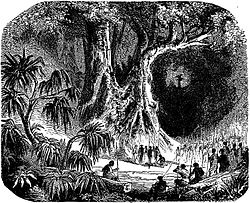

The tangena ordeal was a form of trial by ordeal practiced in Madagascar to determine the guilt or innocence of an accused party. The trial utilized seeds of the tree species Cerbera manghas (family Apocynaceae), which produces seeds that contain highly toxic cardiac glycosides including cerberin and tanghinin.
The tradition of the tangena ordeal, dates to at least the 16th century in Imerina. It has been estimated that the poison may have been responsible for the deaths of as much as 2% of the population of the central province of Madagascar each year on average. Mortality peaked during the reign of Queen Ranavalona I (1828–1861), when the tangena ordeal was used extensively.
The belief in the genuineness and accuracy of the tangena ordeal was so strongly held among all that innocent people suspected of an offence did not hesitate to subject themselves to it; some even showed eagerness to be tested. The use of ritual poison in Madagascar was abolished in 1863 by King Radama II, but its use persisted for at least several decades after being officially banned.